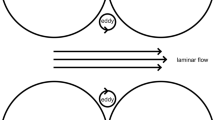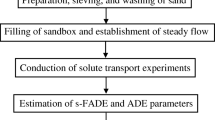Abstract
Solute (NaCl) miscible displacement experiments are performed on long disturbed soil columns to determine the hydrodynamic longitudinal dispersion coefficient and correlate it with the variability of the local permeability. The solute concentration, averaged over several cross-sections along the soil column, is monitored by measuring the electrical resistance between rod electrodes. The measured solute concentration breakthrough curves are fitted simultaneously with the one-region and two-region analytical models of the 1-D advection–dispersion equation to estimate the longitudinal dispersion coefficient, D L, as a function of Peclet number, Pe, for common groundwater flow velocities (2 < Pe < 50). Macroscopic simulations of miscible displacement in 2-D porous media described by a periodic permeability field with low, moderate and high variability are employed to evaluate the predictability of the one-region and two-region models, and the sensitivity of the dispersion coefficients and flow velocities estimated from soil column displacement tests to the variance of local permeability. When the variability of the local permeability becomes high, the one-region model fails, while the two-region model is capable of reproducing satisfactorily the breakthrough curves, and providing reliable values of dispersion coefficients. The two mean pore velocities estimated by the two-region model represent, on average, a fast and a slow mean velocity of the dispersion front, whereas their difference is a measure of the transient evolution of the width of the equi-concentration dispersion front.














Similar content being viewed by others
References
Adler, P. M., & Thovert, J.-F. (1999). Fractures and fracture networks: Theory and applications of transport in porous media. Dordrecht, The Netherlands: Kluwer.
Bacri, J.-C., Rakotomalala, N., & Salin, D. (1987). Experimental evidence of disorder effects on hydrodynamic dispersion. Physical Review Letters, 58, 2035–2038.
Bajracharya, K., & Barry, D. A. (1997). Nonequilibrium solute transport parameters and their physical significance: Numerical and experimental results. Journal of Contaminant Hydrology, 24, 185–204.
Bear, J. (1972). Dynamics of fluids in porous media. New York: Elsevier.
Berkowitz, B., Cortis, A., Dentz, M., & Scher, H. (2006). Modeling non-Fickian transport in geological formations as a continuous time random walk. Reviews of Geophysics, 44, RG2003, doi:10.1029/2005RG000178.
Bruderer, C., & Bernabe, Y. (2001). Network modelling of dispersion: Transition from Taylor dispersion in homogeneous networks to mechanical dispersion in very heterogeneous ones. Water Resources Research, 37, 897–908.
Bruggeman, G. A. (1999). Analytical solutions of geohydrological problems. New York: Elsevier.
Charlaix, E., Hulin, J.-P., Leroy, C., & Zarcone, C. (1988). Experimental study of tracer dispersion in flow through two-dimensional networks of etched capillaries. Journal of Physics. D, Applied Physics, 21, 1727–1732.
Comegna, V., Coppola, A., & Sommella, A. (2001). Effectiveness of equilibrium and physical non-equilibrium approaches for interpreting solute transport through undisturbed soil columns. Journal of Contaminant Hydrology, 50, 121–138.
Cortis, A., Chen, Y., Scher, H., & Berkowitz, B. (2004). Quantitative characterization of pore-scale disorder effects on transport in homogeneous granular media. Physical Review E, 70, 041108.
Costa, J. L., & Prunty, L. (2006). Solute transport in fine sandy loam soil under different flow rates. Agricultural Water Management, 83, 111–118.
Detwiler, R. L., Rajaram, H., & Glass, R. J. (2000). Solute transport in variable-aperture fractures: An investigation of the relative importance of Taylor dispersion and macrodispersion. Water Resources Research, 36, 1611–1625.
Ding, A., & Candela, D. (1996). Probing non-local tracer dispersion in flows through porous media. Physical Review E, 54, 656–660.
Drazer, G., Chertcoff, R., Bruno, L., Rosen, M., & Hulin, J. P. (1999). Tracer dispersion in packings of porous activated carbon grains. Chemical Engineering Science, 54, 4137–4144.
Dullien, F. A. L. (1979). Porous media: Fluid transport and pore structure. New York: Elsevier.
Fried, J. J., & Combarnous, M. (1971). Dispersion in porous media. Advances in Hydroscience, 7, 169–282.
Gwo, J. P., O’ Brien, R., & Jardine, P. M. (1998). Mass transfer in structured porous media: Embedding mesoscale structure and microscale hydrodynamics in a two-region model. Journal of Hydrology, 208, 204–222.
Inoue, M., Simunek, J., Shiozawa, S., & Hopmans, J. W. (2000). Simultaneous estimation of soil hydraulic and solute transport parameters from transient infiltration experiments. Advances in Water Resources, 23, 677–688.
Lee, J., Horton, R., Noborio, K., & Jaynes, D. B. (2001). Characterization of preferential flow in undisturbed, structured soil columns using a vertical TDR probe. Journal of Contaminant Hydrology, 51, 131–144.
Lenormand, R. (1995). A stream tube model for miscible flow. Transport in Porous Media, 18, 245–261.
Maier, R. S., Kroll, D. M., Bernard, R. S., Howington, S. E., Peters, J. F., & Davis, H. T. (2000). Pore-scale simulation of dispersion. Physics of Fluids, 12, 2035–2079.
Manz, B., Alexander, P., & Gladen, L. F. (1999). Correlations between dispersion and structure in porous media probed by nuclear magnetic resonance. Physics of Fluids, 11, 259–267.
Peters, E. J., Gharbi, R., & Afzal, N. (1996). A look at dispersion in porous media through computed tomography imaging. Journal of Petroleum Science & Engineering, 15, 23–31.
Schotting, R. J., Moser, H., & Hassanizadeh, S. M. (1999). High-concentration-gradient dispersion in porous media: experiments, analysis and approximations. Advances in Water Resources, 22, 665–680.
Simmons, C. T., Fenstenmaker, T. R., & Sharp, J. M. (2001). Variable-density groundwtare flow and solute transport in heterogeneous porous media: Approaches, resolutions and future challenges. Journal of Contaminant Hydrology, 52, 245–275.
Theodoropoulou, M., Karoutsos, V., Kaspiris, C., & Tsakiroglou, C. D. (2003). A new visualization technique for the study of solute dispersion in model porous media. Journal of Hydrology, 274, 176–197.
Tsakiroglou, C. D., Theodoropoulou, M. A., & Karoutsos, V. (2005b). Buoyancy-driven chaotic regimes during solute dispersion in pore networks. Oil and Gas Science and Technology – Review IFP, 60, 141–159.
Tsakiroglou, C. D., Theodoropoulou, M. A., Karoutsos, V., & Papanicolaou, D. (2005a). Determination of the effective transport coefficients of pore networks from transient immiscible and miscible displacement experiments. Water Resources Research, 41(2), W02014.
Whitaker, S. (1999). The method of volume averaging. Dordrecht, The Netherlands: Kluwer.
Zhang, X., Qi, X., Zhou, X., & Pang, H. (2006). An in situ method to measure the longitudinal and transverse dispersion coefficients of solute transport in soil. Journal of Hydrology, 328, 614–619.
Zinn, B., Meigs, L. C., Harvey, C. F., Haggerty, R., Peplinski, W. J., & Schwerin, C. F. V. (2004). Experimental visualization of solute transport and mass transfer processes in two-dimensional conductivity fields with connected regions of high conductivity. Environmental Science & Technology, 38, 3916–3926.
Acknowledgement
This work was performed under Global Change and Ecosystems contract number SSPI-CT-2003-004017-STRESOIL (2004–2007) supported by the European Commission.
Author information
Authors and Affiliations
Corresponding author
Appendix
Appendix
In soil S2, the grain (or pore) size distribution is very wide (Table 1) and hence, a great variety of mean pore velocities and hydraulic conductances (permeabilities) arises. In order to compute the volume-based distribution of local permeabilities from the weight-based grain-size distribution, the modified Kozeny equation (Dullien 1979)
was used, where λ is a parameter to estimate, and k i , d gi are the mean permeability and mean grain diameter of class, i. Considering that f i (i = 1, 2, 3, 4) are the frequencies for the grain diameters d gi (Table 1), h i (i = 1, 2, 3, 4) are the frequencies for the local permeabilities k i , and using Eq. 24 it is obtained
The average permeability defined by
is not necessarily equal to the overall permeability. Instead, methods of the statistical physics of disordered media are required for calculating the overall permeability from the distribution of local permeabilities. An approach based on the effective medium approximation (EMA), as applied to a 3-D cubic lattice, was used. The disordered medium consists of cubic cells of equal dimensions with permeabilities following the distribution function. This medium is replaced by an effective one consisting of cells of identical permeability k m so that the overall perturbation caused on the flow field vanishes. Evidently, the foregoing condition is not valid for a very wide distribution of local permeabilities. The EMA is expressed by the algebraic relation
By setting the effective permeability, k m , equal to the experimentally measured value of the overall permeability of S2 (k exp = 21.8 Da) and solving Eq. 27 we obtained the parameter λ = 6.3165 × 10−4 and the local permeability distribution shown in Table 9.
Rights and permissions
About this article
Cite this article
Aggelopoulos, C.A., Tsakiroglou, C.D. The Longitudinal Dispersion Coefficient of Soils as Related to the Variability of Local Permeability. Water Air Soil Pollut 185, 223–237 (2007). https://doi.org/10.1007/s11270-007-9445-6
Received:
Accepted:
Published:
Issue Date:
DOI: https://doi.org/10.1007/s11270-007-9445-6




